Seventy bikes over 80 years old travelling more than 6000km across the US – what could possibly go wrong?
The 2012 Motorcycle Cannonball had all the makings of an epic tale as riders pitted themselves against each other, not only for their mechanical and riding skills, but for their physical and mental prowess as well. It attracted participants from around the globe who share a love for old motorcycles and, for one reason or another, were compelled to test themselves and their machines in this very unique way. Nearly 70 bikes made it to Newburgh, New York to create an assembly of antique machines that could only be rivalled by displays in the finest museums, and which had never before been put together to ride like this.
Could these old machines make the gruelling, mostly-secondary-road, 6367km, coast-to-coast journey with its unexpected turns of bad weather, bad roads and bad timing which would surely be thrown in to spice the pot? Sleep-deprived riders had to deal with seized pistons, flat tyres, bad magnetos, bent forks, cracked frames and left-turning drivers. Some had been through this before on the first Cannonball in 2010 but to ensure it wouldn’t be too easy with newer bikes, the route was extended about 25 percent from the first run; bigger climbs were added, greater altitudes reached and there were to be longer days, all while keeping to the same 16-stage (plus one rest day) format. Points were awarded for kilometres ridden and deducted for penalties, with ties broken based on engine displacement (400-1000-plus cc), age of the bike (1913-1929) and, if need be, age of the rider (20-70).
As we assembled in Newburgh for the start, there was excitement in the air balanced with a healthy dose of trepidation. Most teams scurried about performing last-minute adjustments to bikes deemed Cannonball-ready weeks earlier, but some riders were still trying to get their bikes running. While one bike made it just over a kilometre and a half and two bikes never left the start that day, 57 bikes successfully ran the entire 335km for the stage to Wellsboro, Pennsylvania.
Stage one proved to be a good warm-up as the next two days got serious with increased distance (515km on stage two and 480km on stage three), serious rain, some interstate riding, road closures, accidents and a deadline to be at the ferry in Muskegon, Michigan by 4pm on Sunday. Serious challenges, indeed, but they didn’t end there. Every stage which followed tested the riders in new ways as our character-full pack crossed this great land.
There isn’t really one tale of the Cannonball but rather 69 completely different stories; one for each of the riders, as the variety between people and bikes was great – see the sidebar for the 70th tale; my own. Ages varied from 20-year-old Buck Carson (#3) to 70-year-old Victor Boocock (#56), and from the very simple 1913 Excelsior single-speed twin to nearly a quarter of the pack being on a 1929 bike; either a Harley-Davidson JD or in-line four Henderson. Riders came from all over the USA and 10 other countries: Australia, Canada, England, France, Germany, Ireland, Italy, Japan, Poland, and South Africa. In addition to the American-made Harley-Davidsons, Indians, Excelsiors and Hendersons, overseas brands represented included the British Rudge, BSA, Triumph, Sunbeam and Velocette, German BMWs and the Australian Invincible JAP.

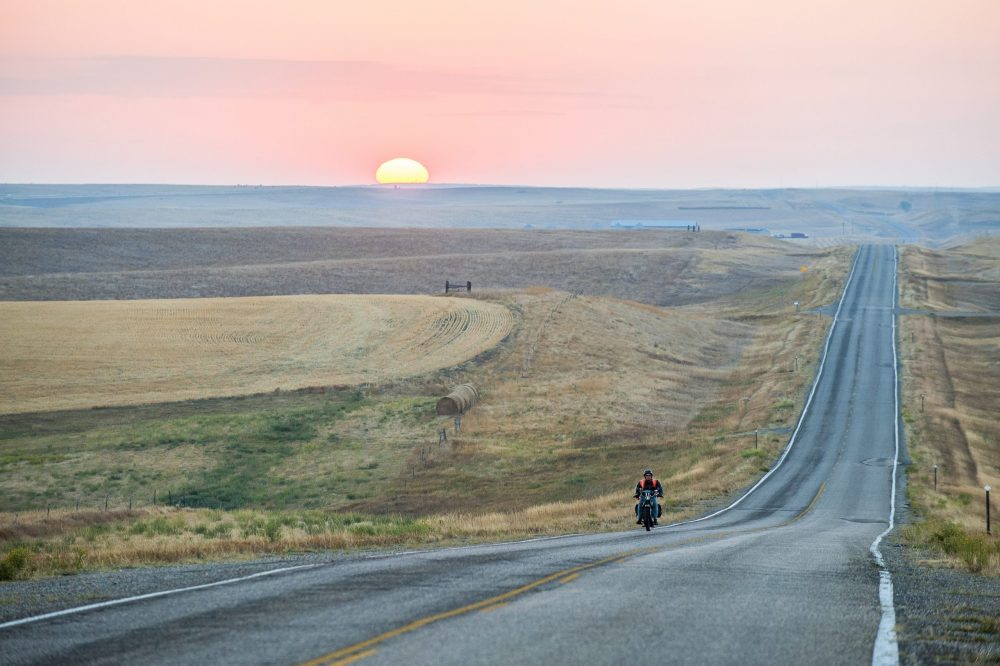
And there was a huge difference in how they approached the Cannonball. Some had owned their bikes for many years and, having already rebuilt them over and over, already understood every clearance in the motor and nuance in the sounds which come from them. Other riders bought a ready-to-go bike or paid a restorer to go through one for them. Some came with mechanics and trailers outfitted like machine shops while others came with a friend in a pick-up to help out. We are talking diversity here, but let me mention just a few of the many that represent what I see as the very spirit of the Cannonball event.
For starters, there was the youngest Cannonballer Buck Carson (#3) on his 1927 BSA 500 single. Buck had worked with his dad on bikes since he was six years old, and here he was ready and capable to cross the USA on a somewhat underpowered motorcycle. Buck’s days were longer than most between the slower speeds the bike ran at and regular on-road maintenance. Bigger problems arose along the way, including the motor seizing which required a complete rebuild right down to the split cases, but with each challenge that arose came the supreme effort to face them and get back on the road. Thankfully, Buck had a great machine shop-equipped trailer, help from his dad and a number of friends (including fellow competitors), but it was his own attitude that stood out. Buck celebrated his 21st birthday in Murdo, South Dakota – far from his Texas home and peers – but who could have asked for a more memorable 21st birthday? In the end, the bike got the best of Buck and refused to go any further but, determined to make it into San Francisco, he got dropped on the north side of the Golden Gate Bridge and pushed his bike across the 2.7km pedestrian walkway right into the city. Now that’s a spirited individual.
Another stand-out personality was Chris Knoop (#16) of Melbourne, Australia on his also Aussie 1925 Invincible JAP. Chris got a start on every stage of the run and made it full distance on more than half the days, but the JAP proved to be a big challenge as it plodded cross-country and was not quite as invincible as the name suggests. As Chris set out from the start in Newburgh his partner, Christina, sat with a huge grin in the wicker sidecar attached to the bike which Chris had made by hand himself. The sidecar was more of a strain than this 1925 bike had bargained for, to the extent that by stage four Chris had to continue on just two wheels. He was still plagued with problems, like when his clutch basket burst apart somewhere in Iowa, but amazingly in that instance he continued on with it in this buggered condition for two days until he could remanufacture the part in Lonnie Isam Sr’s competition racing machine shop in Sturgis, SD. Still, for all the problems Chris encountered and his very long days of riding, he could always be found with a big smile helping other riders with their own bike problems.
Shinya Kimura (#80) was the only custom bike builder on the Motorcycle Cannonball and was clearly not in this to win but rather for the experience or, perhaps more accurately, for the journey. For starters, Shinya alternated days riding with his close friend who flew in from Japan, Yoshimasa Niimi; sharing a bike means points are deducted so from the outset the possibility of a perfect score was not attainable. Then there’s the fact Shinya’s 1915 C-3 Indian has not been internally modernised the way many of the bikes on the Cannonball were and because of this it had more than its fair share of problems, as it did when Shinya and Niimi ran the first Cannonball in 2010. Despite their challenges both riders rode in period clothing every day of the run, including the morning we left Yellowstone Lodge at -2.22°C when Niimi was wearing an old full-length military wool coat. Every other rider was outfitted with modern gear to combat the chill but Niimi stayed true to form – I could see the pain on his face as he rode through the chilling fog that morning, but he did it.


There was also a rat pack of in-line Henderson fours that had a spirited rivalry with the Harleys, in particular with Joe Gardella (#14) on his souped-up 1914 twin, as if it were the early days of motorcycling. The Class I riders had huge spirits as their challenge was probably a bit greater than others, like Claudio Femiano (#9) of Italy who plodded along on his little 1926 Sunbeam until it finally gave out, Mike Wild (#25) of England who had such a wonderful smile across his face as he rode his 1925 Rudge through every possible weather condition, Paul d’Orleans (#38) who looked like the happiest man on earth as he rode his 1928 Velocette like a banshee through the Rockies on the four days he was able to do any kilometres and Jim Crain (#42) and his wife, Sylvia, who rode pillion on their 1927 BSA until they finally figured out the bike would stop breaking spokes when he rode solo, and went on to win Class I.
The foreigners, perhaps for coming so far, also had big spirits. Andreas Kaindl (#33) of Germany seemed to never touch his 1924 Henderson Deluxe while covering every kilometre of the run and Hans Coertse (#60) on his 1921 Harley-Davidson J model had to tear his bike completely down, missing one stage to weld a cracked frame and still achieving perfect scores on the remaining 15 stages. Imagine their understanding of the USA having crossed it on two-lane roads passing through sleepy town after sleepy town. Shinya turned to me after a surprise coffee-and-cookie stop in one small town and said this was “the real America”.
I love that Bill Buckingham (#40) got his 1927 Harley-Davidson JD up and running with a borrowed front end the day after a car turned into him during stage three, sending him to hospital in an ambulance. Josh Wilson (#89) also had an inspiring story: he bought his non-working 1929 Indian 101 Scout on eBay just weeks before the event so he worked on it right up until the morning of the start to get it running. He would have had the least experience of everyone with his bike, yet with a can-do attitude and a shoestring budget he completed every kilometre to finish in fifth place overall.
How could I not smile when Steve Barber (#74) would fly by me wearing his trademark shorts on his 1915 Harley-Davidson J. He would slow down only long enough to ask how fast we were going, since he didn’t have a speedo, which was usually about 95km/h in trying to keep up with him. Frank Westfall (#49) and Erik Dunk (#2) would also make me smile – or, more accurately, laugh – as they were just such great characters that I couldn’t resist.
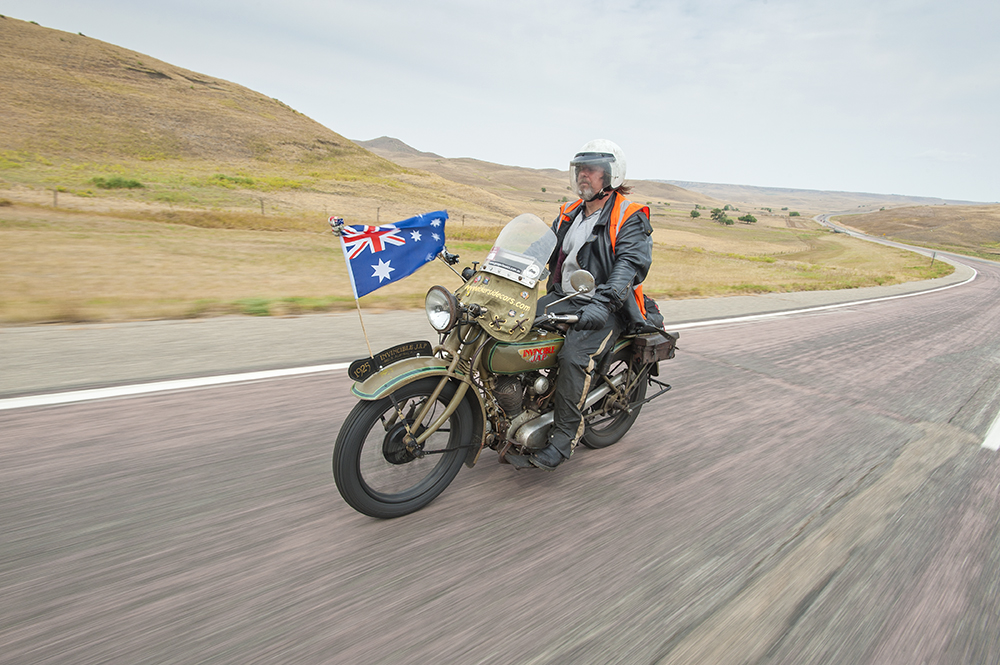
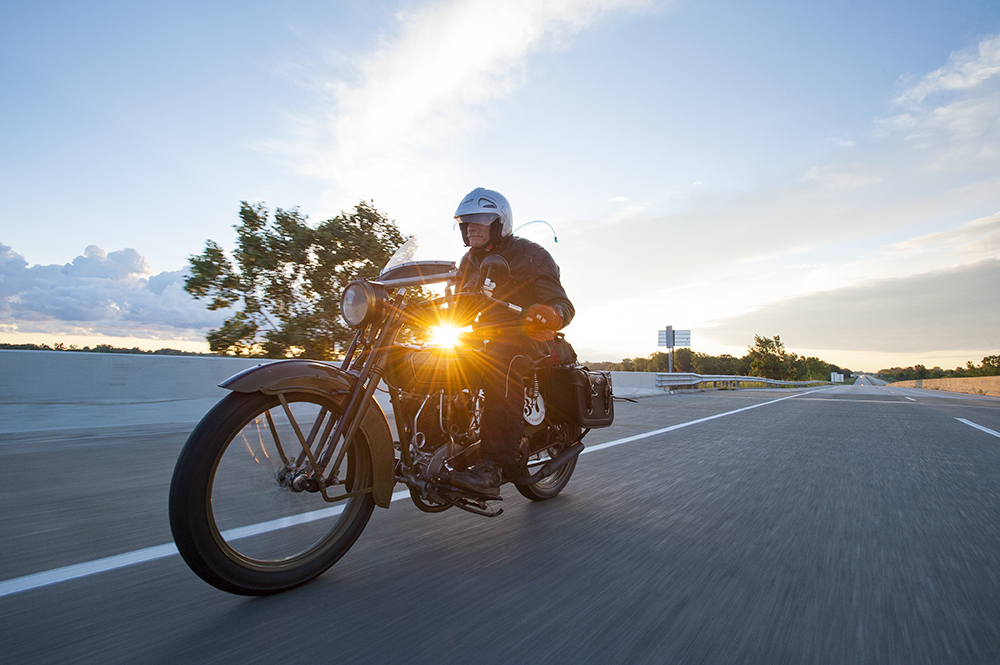
I have to say I had a soft spot for Gary Wright (#57) who signed up for the run as a bucket-list trip of a lifetime, selling a truck and some equipment to afford a 1929 Harley-Davidson JD and a pick-up camper-top so he could make the trip with his wife, Linda, and their old Weimaraner dog that had to be lifted in and out of the camper. Gary was living large and his smile showed it. He wrenched every night and kept the bike running well enough to finish every mile and earn him 17th place.
Victor Boocock (#56) was another rider I felt a soft spot for when I encountered him near the end of stage two after the rain had finally cleared and the sun came out; he had just crashed his 1914 Harley-Davidson and was on the side of the road looking very dejected. Victor was scheduled to have his 70th birthday on the Cannonball but when his clincher tyre broke loose and bound up his back wheel, it took the wind right out of his sails. Thankfully, Victor wasn’t seriously hurt and the bike could be repaired. The long skid mark of bare metal rim to pavement was a scary sight and Victor was sounding like he would never ride again but as things turned out, after going back to California to get him and his bike back in shape, he came out to ride with everyone for the last three days
and was totally back to enjoying himself.
I presume there is still interest in the competitive side of the Motorcycle Cannonball, so let me turn to Brad Wilmarth who ran the #1 plate for winning the 2010 Motorcycle Cannonball on the very same 1913 single-speed Excelsior he was riding this year. Brad’s bike is one of the simpler bikes on the run and, as such, he has kept it true to its roots. His approach to the Cannonball was also one of the simpler approaches as he had just his nephew, Ted, as his solo crewmember and a small pick-up truck as their support vehicle. At the end of each day’s ride, they would go through the bike in the hotel parking lot doing regular maintenance and any repairs that needed to be done, then lift the bike back into the truck where it was stored overnight. There never seemed to be any rush about them, just a cool manner that extended to the way Brad rode. He seemed to rhythmically look ahead, to one side then to the other, down to his route sheet, a half pedal to change leg position and then look ahead again – steady as a rock at 65km/h. He only appeared flustered if someone were to get in his way, as his brakes weren’t the most dependable and he hated slowing for turns. If there was any way he could avoid stopping at a stop sign, he would, but if he did have to halt, some quick pedalling got him back in the action. This seemingly uncompetitive person once again stayed on target and took the big honours as the overall winner of the Motorcycle Cannonball II. Accolades go to Brad for being on the oldest bike to run this Cannonball and for being able to win it twice, logging more than 11,260km on this 1913 machine at the same time.
While I pointed out a number of the hardships, I must also say 19 of the bikes ran every single bumpy bit of the ride. Two more were shy by just 10km and a total of 41 bikes ran more than 4800km. These are impressive numbers for museum-quality bikes that most collectors would only take off their pedestals for the occasional parade.
When it was all said and done, everyone suffered a bit of withdrawal from the Cannonball. The gruelling days were over but with it was that incredible daily sense of purpose. Strong memories and close friendships were made that will last a lifetime; many will come back if and when there is another Motorcycle Cannonball but for that, we will have to wait for Lonnie Isam, Jr – the man whose dream this was and who managed to bring it to life – to ponder how Cannonball II went. Will another Cannonball be viable? Will it be extended to pre-WWII or maybe just 1935? Will a new group of people come out to try their hand?
I’m still exhausted and nearly wasted from the long hours and days of hardly sleeping. There is nothing more immediate and gratifying than seeing these old machines running across the country.
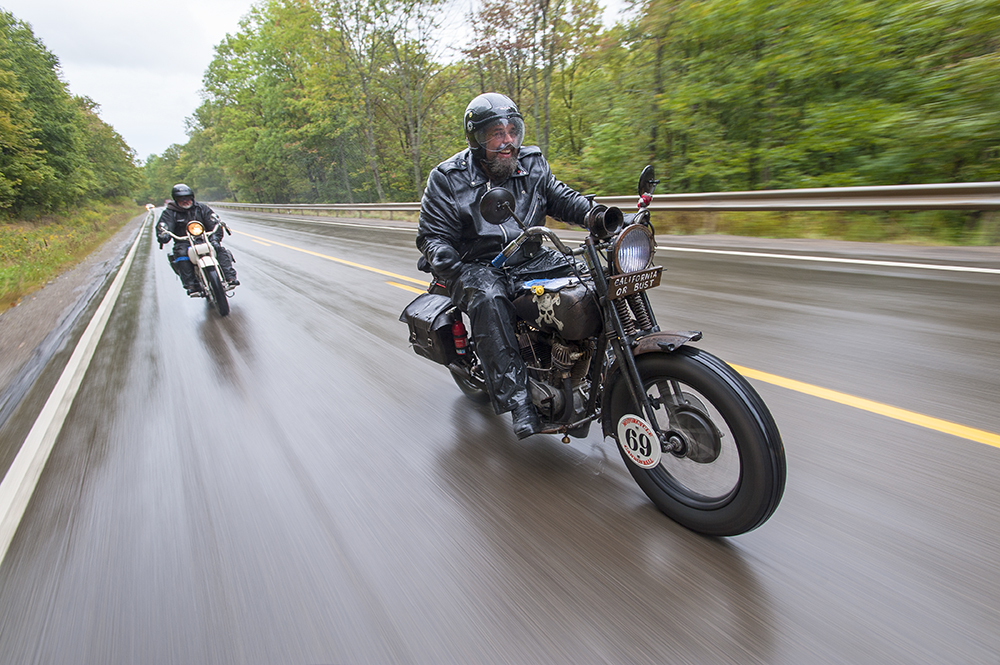
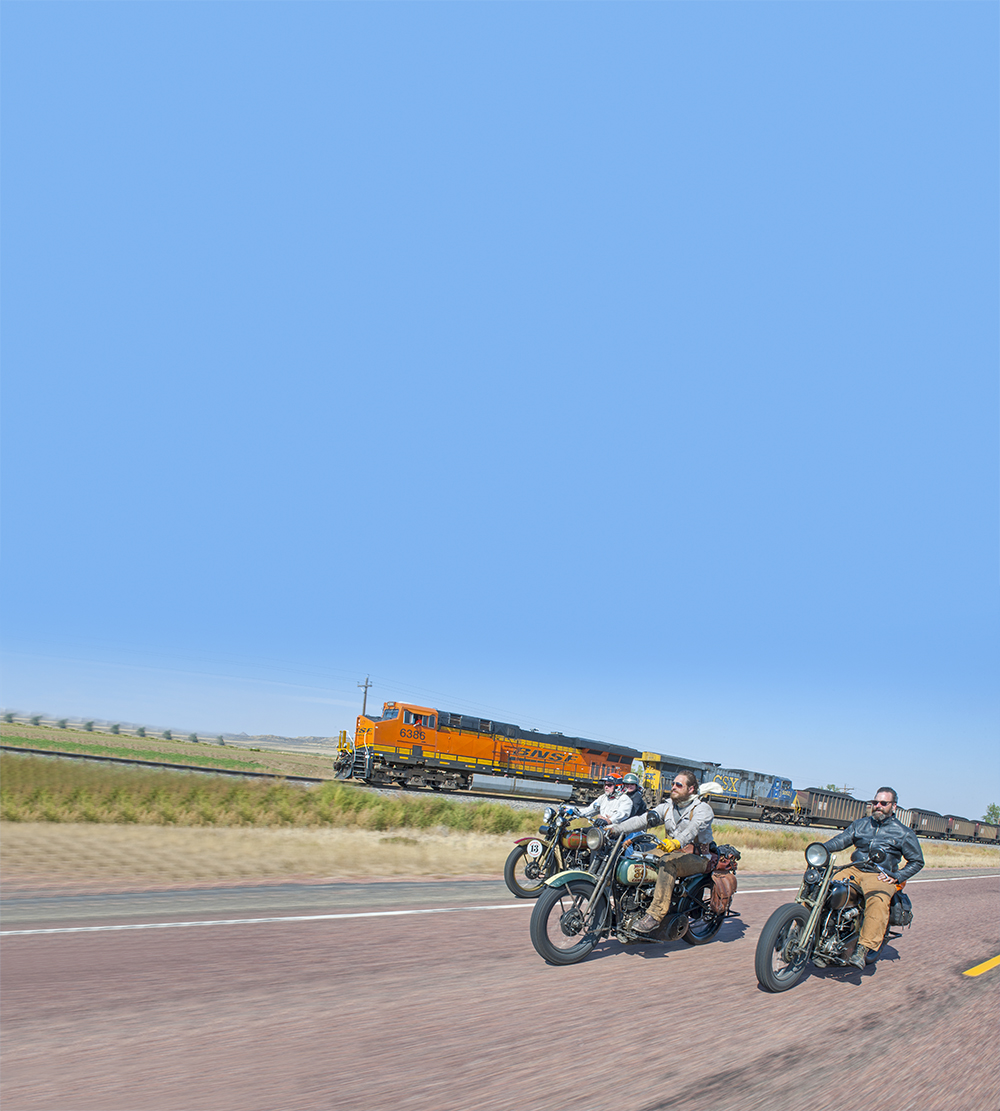
STORY AND PHOTOGRAPHY MICHAEL LICHTER